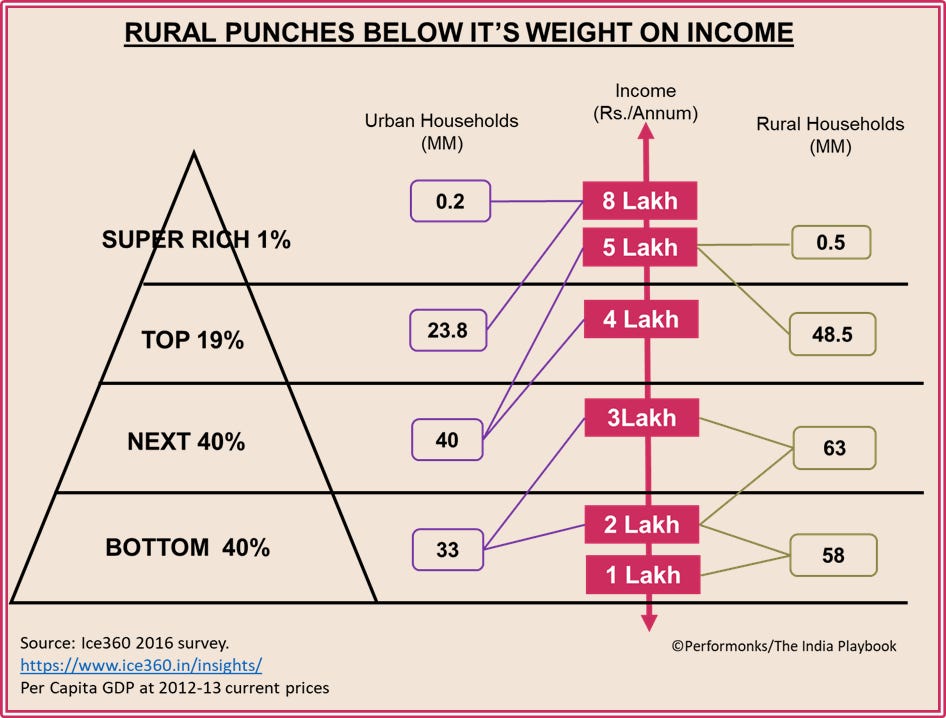From a $0.5 trillion economy in 2001 to $3 trillion in 2022
The flywheel of upward mobility continues to pick up speed in India.
The country added $1 trillion of GDP in the sixty years after independence (1947-2007).
The next trillion was added over the next nine years (2016).
And the third trillion came within the next six years (2022).

If all goes well, India will add another two trillion in GDP in just four years – by 2027.
When the watermark rises, all ships float upwards. However, the share of rural in India’s GDP has declined. It was 46% in 2022. It was 62% in the 1970s.
Yet, when large consumer goods companies report quarterly results, they highlight rural demand’s impact on their revenues.
So why is rural so important?
Feature 1: The weight of rural India
Rural India cannot be ignored- 34% of the consumer goods industry sells in rural areas, and 66% of India lives in rural areas1.
Let’s see the weight of rural population in real numbers.
In an earlier edition, we looked at the four distinct consumer markets that make up India.
When we use the same data source and divide the four markets by urban and rural in the chart below, we see that more people live in rural areas across all four markets.

Feature 2: Rural population weight more than makes up for the lower penetration of consumer goods.
Rural household penetration is lower than urban household penetration for most consumer goods. Let’s take the example of hand sanitizer. As per Kantar in Economic Times2, urban India is far ahead at 40.1%, vs. rural India at 22.3%.
But even with lower penetration numbers, more rural homes bought hand sanitizer than urban homes (44.4 million homes in rural vs. 42.6 million in urban).
Feature 3: Even though rural pulls in the population numbers, it punches far below its weight in consumption.
Across all four consumer segments, the rural home has a lower income than a similar household in urban India.
The chart below shows that even the super-rich in rural areas are not as wealthy as those in urban areas – the rural super-rich earn Rs.5 lakh a year, while the urban super-rich earn Rs.8 lakh a year.

There is scope to grow both penetration and consumption in rural areas, provided prices are within reach. A rule of thumb is to enter Rural India 1 (super-rich 1%) and Rural India 2 (Top 19%) with prices that work with Urban India 3 (Next 40%).
But growing rural goes beyond just getting prices right. Not only does the rural consumer continue to surprise us, but it is also a volatile consumer base.
Feature 4: Rural works counterintuitively to urban.
Businesses cannot blindly copy-paste their urban product-price mix for rural markets. Let’s take the hand sanitizer example once more. One would think that since urban India has adopted liquid hand wash (urban penetration at 55.4%), rural consumers will mirror this behavior. Not true. Rural consumers seem to have decided that hand sanitizer and their regular toilet soap are enough – rural penetration of liquid hand wash is only 18.7%.
Feature 5: Rural demand is subject to double jeopardy.
The most interesting feature of rural India is that its purchasing power suffers from a double jeopardy effect – not only is its purchasing power low, but it is also volatile.
Low purchasing power: The average rural household spends as much as 65% of its income on essentials like food and fuel (NSS 2009-10), Vs. 51% spent by the average urban household. After spending on education (4%) and medical (5%), they have little money left over for impulse enjoyment or nonessential purchases.
On top of that, rural demand is volatile: 35% of rural households derive their income from agriculture. Agricultural income, by nature, is volatile. It depends on that year’s market yields, the health of the monsoon, and the resultant inflation.
That’s the double jeopardy – even the already low purchasing power for essential purchases can get knocked off in the face of a bad monsoon year or some other market disruption.
That’s why, the year strong rural demand kicks in, consumer goods companies have a spring in their step.
Thanks for reading.
p.s. The India Playbook is a ‘build in public’ project. Let me know if you have any suggestions on how I could make this better.
Footnotes
- The definition of rural in India is when all three are true in a census – a) population of less than 5,000 , b) a population density of less than 400 people per square kilometer, and c) at least 25% of male population is engaged in agriculture as source of income ↩︎
- Link to article ↩︎
